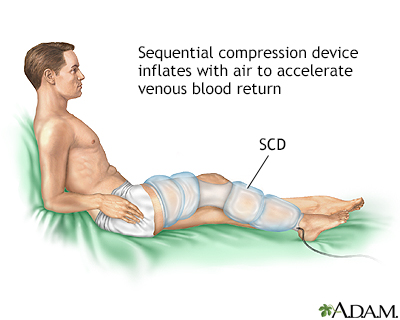Venous thrombosis
| Normal anatomy |
|
Veins carry blood back to the heart from the tissues. Blood flowing in the veins is under lower pressure and moves more slowly than blood flowing in the arteries. Blood is therefore more likely to clot in the veins, thus blocking the flow through the veins.
|
|
| Indications |
|
Blood clot formation in the veins is called venous thrombosis. Venous thrombosis most commonly forms in the veins of the legs. Risk factors for venous thrombosis include prolonged bed rest or immobility, as can be necessary after surgery, cancer, and estrogen therapy.
|
|
| Procedure, part 1 |
|
Venous thrombosis can cause swelling and pain of the leg in which it forms. Large clots can also break free and travel to the heart and lungs, where they can cause cardiac arrest and sometimes death. This is called pulmonary embolism.
|
|
| Procedure, part 2 |
|
Venous thrombosis of the legs is diagnosed by ultrasound. Treatment usually involves medication to thin the blood and dissolve the thrombosis. Two common medications are heparin and coumadin.
If patients are not candidates for blood-thinning medication (such as patients with a history of stroke or bleeding), a filter is placed in the large vein leading from the leg to the heart, to catch any clot that may embolize up toward the heart. These filters can be inserted through a catheter inserted in the veins of the groin.
|
|
| Aftercare |
|
Post-operative patients are at risk for pulmonary embolism because of the time spent in bed after surgery. One method for reducing the risk of venous thrombosis is the use of sequential compression devices (SCDs). These are stockings that wrap around the legs and periodically inflate and deflate with air.
In part, this prevents the formation of thrombosis in the leg veins by increasing blood flow through the veins. The use of SCDs and early ambulation after surgery greatly reduces the risk of venous thrombosis and pulmonary embolism. Walking immediately after surgery also reduces the risk of thrombosis and pulmonary embolism.
SCDs are used after many major surgeries until patients are able to walk regularly on their own.
|
|

Review Date:
4/1/2025
Reviewed By:
Linda J. Vorvick, MD, Clinical Professor Emeritus, Department of Family Medicine, UW Medicine, School of Medicine, University of Washington, Seattle, WA. Also reviewed by David C. Dugdale, MD, Medical Director, Brenda Conaway, Editorial Director, and the A.D.A.M. Editorial team.
The information provided herein should not be used during any medical emergency or for the diagnosis or treatment of any medical condition. A licensed medical professional should be consulted for diagnosis and treatment of any and all medical conditions. Links to other sites are provided for information only -- they do not constitute endorsements of those other sites. No warranty of any kind, either expressed or implied, is made as to the accuracy, reliability, timeliness, or correctness of any translations made by a third-party service of the information provided herein into any other language. © 1997-
A.D.A.M., a business unit of Ebix, Inc. Any duplication or distribution of the information contained herein is strictly prohibited.
© 1997-

All rights reserved.






